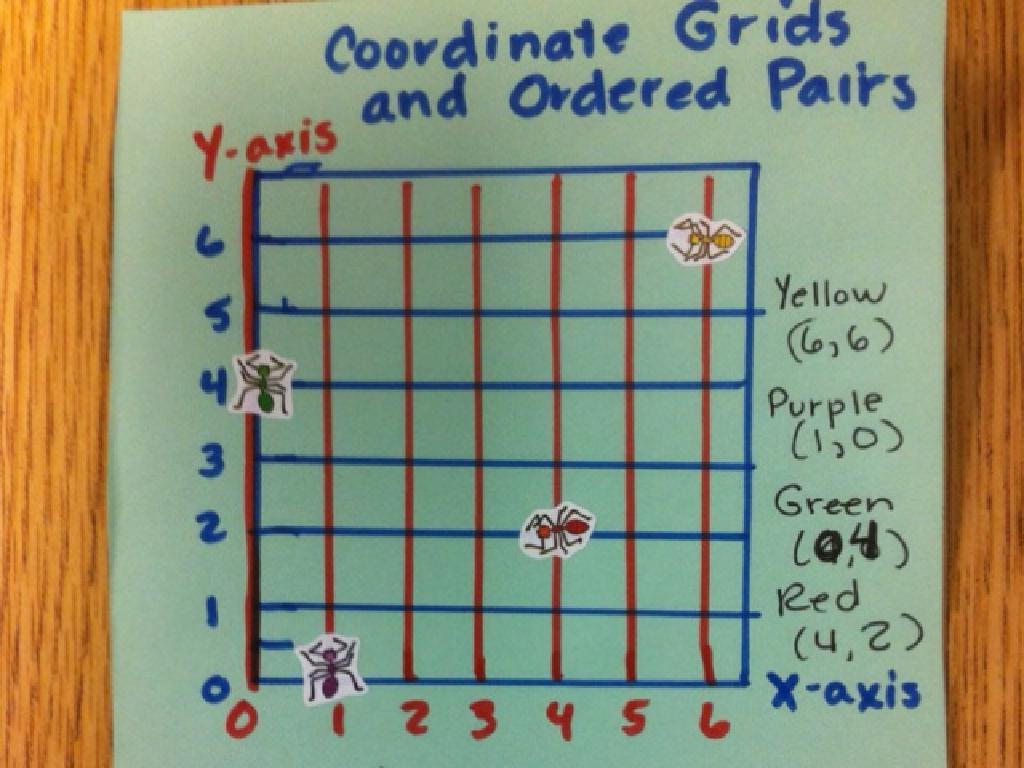Interpret The Slope And Y-Intercept Of A Linear Function
Subject: Math
Grade: Eighth grade
Topic: Linear Functions
Please LOG IN to download the presentation. Access is available to registered users only.
View More Content
Interpreting Slope and Y-Intercept
– Define linear functions
– A linear function creates a straight line graph
– Slope: Rate of change
– Slope indicates how steep the line is
– Y-intercept: Starting point
– Y-intercept is where the line crosses the Y-axis
– Graphing linear functions
– Use slope and y-intercept to draw the line
|
Today’s lesson will cover the fundamental concepts of linear functions, focusing on two key components: slope and y-intercept. Begin by defining a linear function as an equation that forms a straight line when graphed. Explain that the slope represents the rate of change or how much the ‘y’ value increases or decreases as ‘x’ increases. The y-intercept is the point where the line crosses the y-axis, indicating the value of ‘y’ when ‘x’ is zero. Emphasize the importance of understanding these concepts as they form the basis for graphing linear functions. Provide examples of linear functions and demonstrate how to identify and interpret the slope and y-intercept from both equations and graphs. Encourage students to practice by graphing functions using the slope and y-intercept.
Understanding Linear Functions
– Define a linear function
– A function with a constant rate of change, straight-line graph
– General form: y = mx + b
– ‘m’ represents slope, ‘b’ is y-intercept
– Real-life linear function examples
– E.g., speed of a car over time, monthly savings
– Graphing linear functions
– Plotting points on a graph to visualize the function
|
Introduce the concept of linear functions by defining them as equations that produce a straight line when graphed. Explain the general form y = mx + b, where ‘m’ is the slope indicating the steepness of the line, and ‘b’ is the y-intercept, the point where the line crosses the y-axis. Provide relatable examples such as the constant speed of a car or regular monthly savings to illustrate linear functions in real life. Teach students how to graph these functions by plotting points and drawing the line that represents the function. Emphasize the importance of understanding the slope and y-intercept in interpreting the behavior of linear functions.
Exploring the Slope of Linear Functions
– Slope (m) as rate of change
– Slope indicates how steep a line is; rise over run
– Positive vs. Negative slope
– Positive slope rises, negative slope falls
– Zero slope characteristics
– Zero slope means a flat, horizontal line
– Undefined slope explanation
– Undefined slope: vertical line, no run
|
This slide aims to help students understand the concept of slope (m) in linear functions. The slope is the rate at which the y-value of a function changes with respect to its x-value, often described as ‘rise over run.’ A positive slope indicates an upward trend, while a negative slope indicates a downward trend. A zero slope represents a horizontal line, which means there is no change in y as x changes, indicating a constant function. An undefined slope is characteristic of a vertical line where the change in x is zero, which cannot be expressed as a ratio. Use graph examples to illustrate each type of slope and encourage students to practice by identifying the slope from various linear equations and graphs.
Calculating the Slope of a Line
– Understand the slope formula
– Slope (m) measures steepness of a line: m = (y2 – y1) / (x2 – x1)
– Example: Calculate slope together
– Let’s find the slope of points (2, 3) and (4, 7)
– Practice problem on slope
– Try finding the slope for points (5, 1) and (1, 9)
– Discuss slope interpretation
|
This slide introduces the concept of slope and its calculation using the slope formula. Start by explaining that the slope represents the rate of change between any two points on a line. Work through an example calculation as a class to demonstrate how to apply the formula. Provide a practice problem for students to solve independently, reinforcing their understanding of the concept. Discuss how the slope affects the angle of the line and what it tells us about the relationship between variables in a linear function. Encourage students to ask questions and provide assistance as needed during the practice.
Understanding the Y-intercept of Linear Functions
– Define the y-intercept
– The point where the line crosses the Y-axis
– Graphical impact of y-intercept
– Determines the starting point of the line on a graph
– Real-world y-intercept examples
– Starting value in real-life scenarios, e.g., initial savings
– Analyzing y-intercept in equations
– In y = mx + b, b is the y-intercept, showing where the graph begins
|
The y-intercept is a fundamental concept in understanding linear functions. It is the point where the line crosses the vertical Y-axis, which can be seen on the graph of the equation. This point, represented by ‘b’ in the slope-intercept form of a linear equation (y = mx + b), indicates the starting value of the function when x is zero. In real-world terms, the y-intercept could represent the initial amount of money in a savings account before interest is applied, or the starting position of an object before it begins to move. It’s crucial for students to grasp how the y-intercept affects the graph and to interpret its value in the context of real-life situations. Encourage students to find the y-intercept in various linear equations and to consider its meaning in practical examples.
Interpreting Slope and Y-intercept Together
– Slope defines line’s steepness
– Y-intercept: where line crosses y-axis
– Contextual examples of slope & y-intercept
– E.g., In y=mx+b, m is slope, b is y-intercept. If m=2, b=3, line rises 2 units for every 1 unit right, starts at (0,3).
– Group activity: Graphs & equations match-up
– Students will work in groups to match given graphs with their corresponding linear equations.
|
This slide aims to help students understand how the slope and y-intercept of a linear function determine the behavior of a line on a graph. The slope indicates the line’s steepness and direction, while the y-intercept is the point where the line crosses the y-axis. Provide real-life examples, such as the relationship between distance and time in a speed context, to illustrate the concepts. For the group activity, prepare several graphs and their equations on cards. Students will collaborate to match each graph with its equation, reinforcing their understanding of how slope and y-intercept affect the line’s appearance. This interactive session will cater to different learning styles and promote peer learning.
Graphing Linear Functions
– Graphing lines using slope and y-intercept
– Slope measures steepness, y-intercept is where line crosses y-axis
– Practice with provided slope/y-intercept
– Use the formula y = mx + b to plot
– Class exercise: Graph your linear function
– Choose a slope and y-intercept, then draw the line on graph paper
|
This slide is aimed at helping students understand how to graph linear functions using the slope and y-intercept. Begin by explaining that the slope indicates the steepness of the line and the y-intercept is the point where the line crosses the y-axis. Provide practice examples with different slopes and y-intercepts for students to plot on a graph. For the class exercise, encourage creativity by allowing students to create their own linear function. They should pick a slope and y-intercept, use the formula y = mx + b, and graph the resulting line. This hands-on activity will reinforce their understanding of how slope and y-intercept affect the graph of a linear function. Provide guidance and ensure each student can plot at least one function correctly.
Real-World Applications of Linear Functions
– Linear functions in daily life
– Importance of slope and y-intercept
– Slope indicates rate of change, y-intercept is the starting value
– Scenarios using linear concepts
– Examples: budgeting, speed of a car, or temperature change
– Class discussion on real-life examples
– Share personal observations where you’ve seen linear relationships
|
This slide aims to connect the abstract concept of linear functions to tangible real-world applications that students can relate to. Emphasize the slope as a measure of how things change, like speed or cost over time, and the y-intercept as where we begin, such as a starting amount of money or the initial temperature. Encourage students to think of scenarios in their lives where they have unknowingly used the concept of slope and y-intercept, such as saving money over time or observing the rate at which a shadow grows as the day progresses. During the class discussion, facilitate a brainstorming session where students can share and discuss their examples, fostering a deeper understanding of the material through peer learning.
Class Activity: Slope-Intercept Exploration
– Pair up and pick a real-world linear function
– Determine the function’s slope and y-intercept
– Interpret the slope and y-intercept’s meaning
– Slope: rate of change; y-intercept: starting value
– Present your findings to the class
|
This activity is designed to help students apply their understanding of linear functions to real-world contexts. In pairs, students will choose a situation that can be modeled by a linear function, such as the cost of a taxi ride (base fare plus a charge per mile) or the temperature change over time. They will then identify the slope and y-intercept of the function and discuss what these components represent in their chosen context. The slope indicates the rate of change, while the y-intercept represents the starting value. After analyzing their function, students will present their findings to the class, explaining how the slope and y-intercept relate to the real-world situation. This will reinforce their comprehension of linear functions and their components. Possible activities for different pairs could include analyzing data from sports statistics, science experiments, or financial growth over time.
Review and Homework: Slope and Y-Intercept
– Summarize today’s key points
– Recall slope as rate of change, y-intercept as start point
– Homework: Slope & y-intercept worksheet
– Solve problems to solidify understanding of linear functions
– Reminder: Discuss homework next class
– Be ready to explain your solutions and thought process
– Practice makes perfect!
|
This slide is meant to wrap up the day’s lesson on interpreting the slope and y-intercept of linear functions. Students should be reminded of the importance of slope as the rate of change and the y-intercept as the starting point of the line on a graph. The homework assignment is a worksheet that will help students practice and reinforce their understanding of these concepts. Encourage students to be thorough in their work as they will be expected to discuss the problems and their solutions in the next class. This practice is crucial for their mastery of linear functions and will aid in their overall mathematical development.






